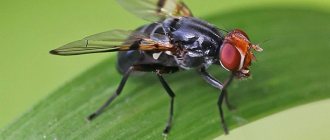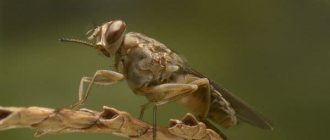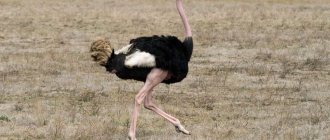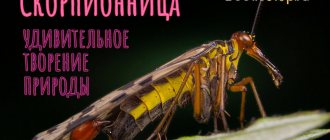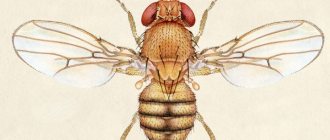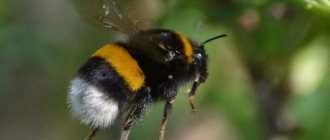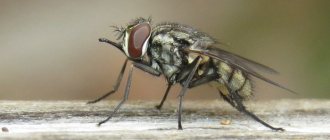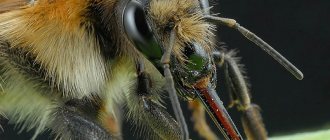The tsetse fly (a representative of the family GLOSSINIDAE) is an insect that poses a danger to humans. The fly lives in the tropics and subtropics of the African continent. About fifty thousand people die every year due to insect bites. She is called the "silent killer." There are 23 species of such insects, and 6 species of flies are carriers of a disease called sleeping parasites that transmit parasites to humans.
Appearance
The tsetse fly has a body length of 10-14 millimeters and can be divided into three components: head, chest, abdomen. Dark brown large eyes are located on the head. The chest consists of three fused segments. Wings are attached to the chest part and six legs extend from it. The body is gray-red in color, with 4 brown stripes running along the back. The fly has a wide but short belly. Characteristic features of the tsetse:
- long and hard trunk, looking forward;
- stacked together overlapping wings and veins with axe-like outlines;
- antennae with forked ends.
The fly's mouth is designed like this: the lower lip has a pointed tongue, and the upper lip has an elongated shape. Having pierced the skin of the victim with its trunk, the tsetse injects its saliva, which introduces infection. The fly drinks an amount of blood corresponding to its mass. In the belly of the female there is a large uterus in which the larvae are located.
Structure
The body structure of the tsetse fly includes three sections: head, abdomen and thorax.
Additional characteristics:
- The chest consists of three elements fused together.
- Three pairs of paws.
- The oral apparatus of insects includes microscopic elements that can be called teeth. The fly uses them to chew through blood vessels.
- The parasite's saliva contains a special enzyme that prevents the victim's blood from clotting.
Depending on the species, tsetse flies can live near bodies of water and in areas with arid climatic conditions.
Where does it live?
Tsetse settled in the countries of the African continent located in the territories south of the Sahara Desert. It is common:
- in Kenya;
- in Nigeria;
- in Uganda;
- in Cameroon;
- in Gabon, etc.
The tsetse fly's range includes thirty-seven countries. The insect prevents African inhabitants from developing fertile lands. Scientists are looking for methods to destroy tsetse.
The fly began to spread across African territory at the end of the 19th century, when the plague disease was brought to the continent from European countries. This contributed to the destruction of local residents and animals. Abandoned fields and thickets created favorable conditions for the spread of tsetse flies, which destroyed the lives of millions of Africans.
Settlement area
The tsetse fly is found in Africa. Its habitat extends south of the Sahara, between the 14th and 20th parallel south. w. It is observed in equatorial and subequatorial zones. Gabon, Cameroon, Nigeria, Uganda, Kenya - a total of 37 countries on the list. The territory where the tsetse fly lives is home to 32 of the poorest countries in the world. The territory with fertile lands cannot be used due to the presence of the parasite. Scientists are in search of means to destroy Glossina, and enormous amounts of money are being spent on research.
History of the conquest of Africa
The beginning of the mass spread of this dangerous insect is considered to be 1887. It was then that the plague virus was imported from Europe, causing massive deaths of wild animals and livestock. Many local residents who had no immunity to the disease died out. After a few years, the pastures became overgrown with bushes, which became a haven for the tsetse fly. The decrease in the number of people has led to an increase in the number of wild animals. Several factors have come together in such a way that the pests have spread to many areas of Africa where they were not previously found. The spread of Glossina was accompanied by infection of humans with trypanosomes. Millions of people died from sleeping sickness.
Areas occupied by the tsetse fly are free from human economic activity. Most areas contain national wildlife parks.
Lifestyle
Its behavior depends on the type of tsetse fly:
- A tsetse species called Glossina palpalis lives in shrubs and grass near ponds. They pose a danger to people and reptiles.
- In tropical forest zones, where there is high humidity and moderate temperatures, the flies Glossina fusca have settled. This type of fly does not attack humans.
- The flies Glossina morsitans live in the South African savannah zone. They attack people and animals.
The life of a fly lasts six to seven months. They prefer a humid environment. During the dry season, insects move to bodies of water and hide from the heat under plants. At such times they sit and do not want to fly. Food comes to them on its own. In hot weather, animals go to ponds to quench their thirst.
For the tsetse fly, the zebra is of no interest because the black and white stripes on its skin are not perceived by its vision as a living creature. They flash before the eyes of a fly without attracting its attention.
Tsetse is well adapted to dark colors: it attacks people with black skin and animals with dark skin. The tsetse fly is tenacious, flies silently and at high speed.
Hematophagous
Hematophagous flies
Flies that bite are obligate hematophagous flies. This species feeds on blood in its adult stage. The larvae develop in rotting organic matter. Obligate hematophages include: horse flies, autumn flies and tsetse flies, which are often called killer flies.
Interesting!
The largest flies are called horse flies because of their thirst for blood. The female, trying to drink blood and lay eggs, does not feel danger, does not notice anything around her and often dies from the tail of an animal or the hand of a person.
In horseflies, females differ from males in that humans usually do not even see the latter. Male horseflies feed on nectar and do not attack mammals.
Some species of horse flies have green eyes, which is why they are often confused with other large flies with green eyes - aphage botflies.
All obligate hematophages have mouthparts adapted to obtain blood.
Facultative hematophages are not able to independently obtain blood from the victim’s body. They feed on secretions of the skin and mucous membranes. They willingly drink blood protruding from fresh wounds. In addition to secretions, they feed on mammal excrement and plant juices. The larvae develop in excrement.
A typical representative of a facultative hematophage is the market fly, which is very similar to the house fly, but lives only in the southern regions. Distributed throughout Central Asia and Transcaucasia. In Russia it lives in the subtropical zone.
Nutrition
The tsetse fly eats only the blood of warm-blooded artiodactyls and humans. Almost every day they suck it. Flies show different activity: some species fly in the morning, other species fly in the afternoon. In the forests they land on people. Female flies drink blood from large animals, piercing their skin and injecting saliva into their body. To get into a blood vessel, flies use small sharp teeth located at the end of the trunk. The teeth bite through the skin and elastic vascular wall. By injecting saliva into the vessel, containing trace elements that interfere with clotting, the tsetse drinks blood. Her thin belly inflates, taking on a streamlined shape.
The tsetse fly feeds on blood:
- antelope;
- buffalo;
- hare;
- monitor lizard;
- crocodile;
- birds;
- person.
The fly has a large enough belly that it can withstand swelling when sucking out blood fluid.
Distinctive features
The insect is not characterized by the presence of poisonous glands and, in general, looks quite harmless. Its miniature size does not cause visual alarm, but you should remember the structure of this creature in order to avoid unpleasant encounters. The special position of the wings above the body indicates that the fly belongs to this species. She puts them one on top of the other. And if you look closely, you will notice a characteristic plumage pattern that is similar to the shape of an ax.
In addition, a distinctive feature is a peculiar proboscis capable of injecting. Plus, this insect is given away by its size; the length of the fly reaches from 9 to 14 mm. This variety can be recognized by its reddish-gray chest, which is divided by 4 reddish stripes along the body. It is also distinguished by the color of its abdomen, which is yellow on top and gray underneath. Adding to the individual characteristics are hair antennae growing on the insect's head.
Reproduction
Tsetse is a viviparous species of insect, since the embryo initially develops in the uterus of the female. During its life cycle, a tsetse reproduces from 8 to 10 offspring. Mating in a female occurs once. After about 8-9 days, a fertilized egg appears. The larva lives in the uterus of the female, where it grows due to maternal nutrients.
The tsetse fly must take blood three times for the larva to develop normally. If the female fails to eat, the larval embryo dies.
With normal development of the larva, after a nine-day period, it transforms into a pupa, burrowing into a layer of earth. Then the hard outer film of the puparia develops. The pupa develops in three weeks. It has a hard shell with an oblong shape. It contains dark petals with a breathing tail. The pupa is less than one centimeter long.
A fly forms from the shell within a month. After two weeks, the fly can already mate and begins to lay larvae. The period between the birth of a female and her reproduction of the first larva is fifty days. Throughout her life, every nine days, the female tsetse produces a larva.
Life cycle
Tsetse has an unusual method of reproduction associated with an abundant food supply. Technically, it goes through all the standard phases of insect development:
- egg;
- 3 larval stages;
- chrysalis;
- imago.
Life cycle of the tsetse fly
But only the last one can be seen. Until the last larval stage, the fly develops inside the female. During intrauterine development, the larva feeds on an analogue of milk, which is secreted by a modified gland in the uterus. At the third stage, the larva leaves the female and immediately burrows into moist soil. It pupates in the soil.
The development of the pupa lasts 20-30 days. The imago emerging from the cocoon immediately flies in search of a sexual partner and food.
Interesting!
Among the Tsetse, both sexes drink blood.
Flies live for several years. The female lays only one larva at a time. During the year, she can lay only 4-6 units of offspring. But over the course of a fly’s entire life, the number of larvae reaches 31. The female needs high-calorie protein food to live and raise full-fledged offspring. The tsetse's abdomen is designed in such a way that at one time the female can drink as much blood as she weighs.
Natural enemies
The tsetse fly has no enemies in the natural environment. There are small birds in Africa that sometimes eat these flies, but only when they come across them. The main enemy of the fly is man. When a fly is born, it does not have any viruses. She becomes infected by drinking blood from animals that are infected.
People develop and use a variety of methods to destroy flies that are dangerous to health:
- Destruction of all livestock and burning of land. The flies disappeared for a short period of time. But after a while they appeared, as they drank the blood of reptiles and rodents.
- Location of traps near settlements and agricultural land. A dark cloth or animal skin is taken and impregnated with insecticides. Flies are attracted to artificially created odors. The population is decreasing.
- Applying pesticides to animal hides or spraying them using aircraft. No particular effect was observed.
- Deforestation to eliminate the habitual living conditions of the tsetse. There was no result.
- Use of radioactive radiation. It deprives males of the function of reproducing offspring. Males who have received a dose of radiation are distributed to where the females are. Reproduction does not occur during mating, since the eggs are not fertilized.
This method leads to a temporary reduction in the reproduction of insects, because there is no barrier of water between territories and unirradiated males again end up in a certain area, then the flies reproduce again. Today this method is the most effective. Scientists believe that radiation will help eliminate deadly insects, but this will take time: about twenty years.
Origin of the species and description
Photo: Tsetse fly
The word tsetse means "fly" in the Tswana language and the Bantu language of southern Africa. It is believed to be a very old species of insect, as fossil tsetse flies were discovered in fossil beds in Colorado dating back to about 34 million years ago. Some species have also been described in Arabia.
Living tsetse flies are almost exclusively found on the sub-Saharan African continent. 23 species and 8 subspecies of the insect have been identified, but only 6 of them are recognized as carriers of sleeping sickness and are blamed for transmitting two pathogenic human parasites.
Video: Tsetse fly
Tsetse was absent from most of southern and eastern Africa until colonial times. But after a pandemic, plague decimated virtually the entire cattle population in these parts of Africa and resulting famine wiped out most of the human population.
A thorny bush, an ideal landscape for tsetse flies. It grew up where there was pasture for domestic animals and was inhabited by wild mammals. Tsetse and sleeping sickness soon colonized the entire region, virtually eliminating the restoration of agriculture and livestock production.
Interesting fact! Because agriculture cannot function effectively without the benefits of livestock, the tsetse fly has become the root cause of poverty in Africa.
Perhaps without the tsetse fly, today's Africa would have had a completely different appearance. Sleeping sickness has been called "Africa's best wildlife preserver" by some conservationists. They believed that the land, empty of people, full of wild animals, had always been like this. Julian Huxley called the plains of eastern Africa "the surviving sector of the rich natural world as it was before the advent of modern man."
Population
The tsetse fly is distributed over a vast area - ten million square kilometers. These lands are fertile, but they are not cultivated or used for pasture. There is no development in the countries where the tsetse fly lives, and they are very poor. Animal husbandry and crop production do not develop there.
Tsetse infect humans with a disease called African trypanosomiasis. Surveillance is carried out on approximately four million people from fly zones that contain 70 million Africans.
People have been fighting tsetse flies for several decades. This led to a decrease in the natural population. The destruction of limited populations of tsetse flies is facilitated by the method of radiation of males and their spread throughout contaminated areas.
Scientists believe that a decline in the tsetse population does not harm the ecosystem at all. The implementation of insect control devastates regions and they become lifeless. The fly destroys the population, causes them to starve and harms the economies of African countries.
What does the tsetse fly eat?
Photo: Tsetse fly animal
The insect is found in wooded areas, although it can fly short distances into open meadows when attracted to a warm-blooded animal. Both sexes suck blood almost daily, but daily activity varies depending on the species and environmental factors (such as temperature).
Some species are especially active in the morning, while others are more active during the afternoon. In general, tsetse fly activity decreases shortly after sunset. In forest environments, tsetse flies are responsible for the majority of attacks on humans. Females usually feed on larger animals. They pierce the skin with a thin proboscis, inject saliva and feed themselves.
On a note! insect
Arthropods Diptera Glossinidae Tsetse It lurks in the bushes and begins to pursue a moving target, reacting to the rising dust. It could be a large animal or a car. Therefore, in areas where the tsetse fly is widespread, it is not recommended to drive in the back of a car or with the windows open.
It bites mainly artiodactyl animals (antelope, buffalo). Also crocodiles, birds, monitor lizards, hares and humans. Her belly is large enough to accommodate the increase in size as she absorbs blood, as she takes in blood fluid equal to her own weight.
Tsetse flies are taxonomically and ecologically classified into three groups:
- Fusca or forest group (subgenus Austenina);
- Morsitans, or savannah, group (genus Glossina);
- Palpalis, or river group (subgenus Nemorhina).
Medically important species and subspecies belong to the riverine and shroud groups. The two most significant vectors of sleeping sickness are Glossina palpalis, which is found primarily in dense riparian vegetation, and G. morsitans, which feeds in more open woodland areas.
G. palpalis is the primary host of the parasite Trypanosoma gambiense, which causes sleeping sickness throughout West and Central Africa. G. morsitans is the primary host of T. brucei rhodesiense, which causes sleeping sickness in the highlands of eastern Africa. G. morsitans also carries trypanosomes that cause infection.
Virus transmission
When sucking blood from people and animals, tsetse flies introduce single-celled trypanosome parasites into the body. They cause a dangerous, fatal disease called trypanosomiasis.
A parasite that enters the human circulatory system completely destroys the immune system, and then all nerve cells. First, inflammation of the lymph nodes begins, tumors appear on the throat, then painful tumors completely cover the body. A person develops a fever, headaches, a state of drowsiness, apathy, weakness, and loss of appetite. Trypanosomes, once in the human body, are able to change protein shells, resulting in several thousand forms. Therefore, they pose a mortal danger and one drug is not enough for treatment.
Trypanosomes, which are fatal to humans, are found in the circulatory system of antelopes living in African territories. They do not harm antelopes. The parasitic trypanosome is transmitted from antelope to humans or domestic animals through the bites of tsetse flies. Trypanosome, having penetrated the blood, begins to change the shell of its protein.
During tourist trips to countries located in the equatorial belt, you need to take precautions. Be sure to get vaccinated to prevent infection with trypanosomes.
These single-celled parasites cause the following dangerous diseases:
- Rhodesian sleeping sickness. Its symptoms appear a week after infection. If treatment is not started in a timely manner, death occurs. The first sign: the appearance of an ulcer on any limb, similar to a boil. After two or three weeks it heals, but the scar remains. Then fever begins, pain in the head and joints occurs, spots appear on the skin, and sleep is disturbed.
- Gambian sleeping sickness. The symptoms are exactly the same as the previous disease; it develops much more slowly, four to five months. This disease affects humans and monkeys.
- Invasive disease (nagana) in animals. They develop swelling, fever, and mucus from the eyes and nose. This disease infects all animals except goats and mules (they are immune to the parasite). When animals get sick, farmers face big losses.
How to diagnose and treat sleeping sickness
Tsetse flies move almost silently, so an insect bite is almost impossible to prevent, and you can even notice it only when a chancre appears. In any case, at the slightest suspicion of a bite, you should immediately consult an infectious disease doctor. No folk remedies will help with this disease. The sooner you contact a specialist, the greater the chances of a full recovery. Without treatment, this disease inevitably leads to death.
To diagnose sleeping sickness, a blood test and lumbar puncture (test of fluid in the lymph nodes) are done. Treatment in each case is individual, depending on the form of the disease, the time that has passed since infection, and the condition of the patient. Very toxic drugs are used: Pentamidine, Suramin, organic arsenic compounds; in later stages: Eflornithine and Nifurtimox. When treating with these drugs, one should expect quite severe side effects that can be neutralized in the clinic.
If trypanosomiasis, transmitted through the bites of blood-sucking flies, has been identified in one or more residents of a locality, mass chemical treatment of the population is carried out using the drug Pentamidine
Before going on a trip to Africa, you must inject Pentamidine intramuscularly. On the continent, it is better to avoid the places most favored by tsetse flies, wear light-colored clothing that covers the entire surface of the body, and use insect repellent.
The tsetse fly is a small insect that carries great danger. While African scientists are developing means to combat this scourge, tourists who prefer exotic things should be very careful, follow all preventive measures and, at the first suspicion of sleeping sickness, immediately consult a doctor.
Interesting Facts
- Tsetse flies have lived on Earth for thirty-four million years.
- Male tsetse flies usually attack people, while females love the blood of large animals.
- Female tsetse flies can reproduce four generations in one year, and thirty-one generations of flies over the entire period of their lives.
- Tsetse fly larvae are capable of secreting a very strong toxic substance. One drop of this substance is lethal to humans.
- Every year, approximately three million different animals and three hundred thousand people die from tsetse fly bites.
- “Tsetse” is a name that sounds unusual for many peoples of the globe, but it turns out that when translated from the language of the African population, this word means “killer of an animal.”
- When a tsetse attacks prey, it seeks to feed on blood. If it is nailed, stunned, or its wings are damaged, the fly will use its last strength to get close to its intended victim and even suck the blood out of it as it dies.
- In the perception of programmers, a tsetse fly is a problem associated with a hard drive failure. The inscription that displays the error code contains two English letters SS. Such a hard drive failure can be very dangerous for a computer, almost fatal, similar to a tsetse bite. Therefore, to eliminate this problem, you need to turn to professional programmers.
- The tsetse fly can attack warm objects that move. Sometimes they fall on a moving car that is heated by the engine and sunlight. If a person gets out of the car, the fly will first land on the warm body of the car, and not on him.
Description of the fly
Appearance
The average body length of a fly is 9–14 millimeters.
The body is reddish-gray, has longitudinal stripes, the abdomen is yellowish closer to the head, gray below.
All information sources note that the differences between ordinary house flies and dangerous tsetse flies are negligible, but distinguishable: they can be seen especially in the folding of the wings (the ends of the wings overlap).
The second distinctive feature of the tsetse’s appearance is the piercing proboscis, located on the head at the front below, aimed forward. The next feature that researchers of dangerous flies call is the characteristic pattern on the middle part of the wing, reminiscent of an ax (it consists of veins on the transparent wing). The tsetse also has small hair antennae on its head, which consist of a whole spine and hairs that branch towards the ends.
There are 21 known species of tsetse flies, but not all species are dangerous.
What do they eat?
Tsetse flies have traditionally fed on the blood of wild mammals inhabiting the African continents for about 150 years.
Reproduction
Tsetse flies are not like other types of flies; they do not lay eggs.
All known species of tsetse flies are viviparous; at birth, their larvae are completely ready for the pupation process. The female carries the larva for 7 to 14 days, lays it on the ground, into which it immediately buries itself and pupates. The fly gives birth to larvae about 8-10 times during the entire period of its life, that is, it does not live long, considering that it bears each larva with an interval of 2-3 months.
Habitats
Tsetse flies have chosen the most suitable habitats for themselves - these are mainly damp lands of tropical forests, as well as areas near water bodies. People are forced to give up cultivating fertile lands along the rivers, as this is the usual popular habitat for the tsetse.
With the expansion of forested savannah territories, there was an increase in certain species of tsetse flies, including carriers of deadly infections.
Symptoms of trypanosomiasis infection
Symptoms depend on the severity of the disease and the length of residence of the pathogen in the body.
A person should be alert to the following signs:
- foci of tumors on the skin;
- itching;
- headache;
- painful sensations in the joints;
- fever;
- weakness;
- apathy and drowsiness.
The second stage of the disease is manifested by impaired coordination of movements, numbness of various parts of the body, and confusion. The second stage carries mortal danger.
How to fight this parasite?
Methods of the last century
For many years, humanity has been trying to develop effective means of combating this dangerous insect. The technology for reducing the tsetse fly population was first developed in the 30s of the last century. Its essence was the extermination of all animals on a certain piece of land, from whose blood it feeds. This bold and radical method was successful - on the island of Principe in Africa, thanks to it, all the flies disappeared. After more
After 10 years, the insect appeared there again and began to reproduce, but this time the flies were no longer carriers of trypanosome parasites.
Later, in the 40s, another method was tried, which involved the destruction of vegetation. The tsetse fly spends most of its life in trees. Therefore, the absence of trees leads to a decrease in the insect population. Thus, it was decided to create impossible conditions for the fly to live in some areas. However, the use of this method turned out to be dangerous for the environment, and it was resorted to only in cases where an area inhabited by a large number of people was infested with tsetse flies.
Also in the first half of the 20th century, pesticides were used to combat the tsetse fly, which were sprayed by aircraft over the infested area. But this method, like all other control measures using chemicals, turned out to be ineffective. The poison penetrates the food chains of ecosystems and poses a huge danger to all living organisms.
Modern methods
Traps
Oddly enough, such a simple and effective method as traps began to be used only in the second half of the twentieth century.
A standard trap is a cloth soaked in an insecticide solution that attracts flies due to its blue color.
For the same purposes, buffalo skins or any other dark-colored material can be successfully used.
Bait
A careful study of the behavior of flies has allowed scientists to find out what attracts insects to
animals smell of a mixture of substances (acetone and carbon dioxide), which is released when exhaled. Thanks to the wind, the tsetse fly can smell this smell at very long distances. As a result of the research, synthetic variations of the substance exhaled by animals were developed to lure insects into a pesticide trap. But, as it turned out later, the same effect can be achieved by placing half a pumpkin filled with cattle urine the trap.
The safest way to combat the pine cocoon moth is to attract biological enemies of the insect. For those who feed on this pest, read this article.
The bite of a gadfly is very dangerous for both animals and humans, since the larvae of this insect feed on flesh. How to protect yourself and your animals, read the link https://stopvreditel.ru/parazity/zhivotnyx/ovod.html.
Sterilization
The method of sterilizing male tsetse flies has proven to be one of the most effective. Sterilization is carried out using radioactive radiation. After this, males incapable of fertilization are released into the wild in places where there is the highest concentration of healthy individuals. Mating of a healthy female with an irradiated male results in the impossibility of fertilization of the eggs.
Frequent introduction of barren flies into infested regions significantly reduces insect reproduction. As a result, it is possible to reduce the number of deadly flies many times over, which can lead to the complete extinction of the area. Sterilization technology is especially successful when combined with insecticides.
Personal prevention
For these purposes, simple and time-tested methods of protection are used: the door to
the room must be closed, and windows and other open parts must be netted (it is best to use mosquito nets); wear protective clothing and use repellents.
According to scientists, reducing the tsetse fly population does absolutely no harm to the ecosystem. Today, as a result of the fight against this insect, many lifeless, desert regions have been identified in Africa. Thus, the tsetse fly provokes famine, an increase in the mortality rate and economic decline in African countries.
The eccentric American writer and reporter Ambrose Bierce once joked that the bite of a tsetse fly was the best cure for insomnia. There is a bitter truth in the gloomy cynicism of a literary genius: an insect bite does lead to sleeping sickness (African trypanosomiasis), which in many cases is fatal.
In the order of Diptera there are many blood-sucking insects - carriers of dangerous diseases, but hardly anyone can compare with tsetse in bloodthirstiness and the amount of damage caused to the population and fauna of the African continent.
Tsetse fly from Burkina Faso.
If you are planning a safari in the savannahs of Tanzania, rafting on the Zambezi River, or are simply curious about what this unique insect is, it would not hurt to carefully examine the photo of the tsetse fly and take note of a number of important information:
Necrophages
Necrophagous flies
The names of fly species can often be misleading. Such a species as the “dust fly” does not exist in nature. This name most often hides lucilia, which belongs to the group of necrophages. In the garbage dumps themselves, you can find any synanthropic species, including fruit flies. The group of necrophagous flies of the most famous flies includes:
- Lucilia (green);
- gray meat;
- blue meat
They all feed on animal carcasses, but also include food scraps, plant juices and excrement in their diet.
Interesting!
Necrophages are easy to distinguish from other dipterans: all these flies have red eyes. Some may have blood red (gray blowfly) or brick eyes (green).
Lucilia
A very common and well-known emerald green fly, capable of laying eggs on meat left unattended for a couple of minutes.
They often lay eggs in open wounds, where larvae begin to develop by eating rotting flesh. The main habitat of these dipterans near human habitation is slaughterhouses. But larvae can also develop in animal excrement. It takes 1-2 days for the larvae to develop from the egg.
Blue meat
Medium sized insect. Distributed across all continents. Like the green one, it prefers slaughterhouses and decaying meat.
Gray meat
One of the most dangerous carrion flies. Outwardly, it is similar to an ordinary indoor one, but larger and with clearly visible bright red eyes on its head. The species is viviparous. The female only needs to touch the meat with her belly to lay the larva. When emerging, the larva immediately begins to bite into the meat. The location of the larvae's penetration can be determined by the appearance of liquid from decomposing meat.
Symptoms and treatment
The worst thing is that a person may not be aware of a tsetse fly bite for up to three weeks! Therefore, for preventive purposes, people at risk regularly undergo blood tests.
Tsetse fly bite, tsetse kuksil bite of a person.
1-3 weeks after the bite, the first symptoms appear: chills, headache and joint pain, which are often mistaken for manifestations of the flu. Neurological symptoms may take several months to appear. These are drowsiness, confusion, numbness of the limbs, disorder of the vestibular apparatus. By this time, the immune system is seriously compromised and if treatment is not prescribed, the person dies.
Piedwings
This is a family of spotted wing flies. Most of them are small, only a few mm in length. Some species can reach 2 cm. They are harmless to humans, but cause serious damage to crops.
The list of variegated flies includes the Mediterranean fruit fly with a red belly, which is exotic for Russians. Due to its size (up to 5 mm) and similar coloration, the details of which are difficult to distinguish without a microscope, this fly can easily be confused with Drosophila.
The Mediterranean fly is not among the Russian pests, but can be imported along with citrus fruits - the main food for its larvae.
Fighting methods
Despite the fact that tsetse bring certain benefits to the ecosystem, the threat they pose to animals and people forces humanity to constantly fight these insects.
At the beginning of the last century, when the number of livestock declined sharply due to African plague, the number of cases of sleeping sickness infection also decreased. This circumstance served as the reason for the shooting of hundreds of thousands of wild ungulates, lions and elephants, since it gave rise to the assumption that the fly only drinks the blood of large animals. However, mass extermination did not reduce the population of deadly insects - it later turned out that tsetse can also feed on the blood of small rodents, birds and lizards.
When it was discovered that the number of flies in forested areas was much higher, people began actively cutting down trees and bushes. Having found out that this method also did not produce results (and, in addition, caused enormous harm to the environment), the Africans switched to more gentle measures - in particular, they began to build special traps with insecticides.
Deforestation is an extremely radical and not always effective measure against dangerous creatures, in this case the tsetse fly
A very original method of combating tsetse was invented on the islands of the Zanzibar archipelago. Scientists artificially raised several million flies, after which they separated the males from the females and sterilized the former by irradiating them with low doses of radiation. When the males were released, they mated with females, who considered themselves fertilized, but were subsequently unable to produce offspring.
At the moment, this method is the most effective - with its help, scientists expect to completely exterminate the genus Glossina over the next 30 years.
